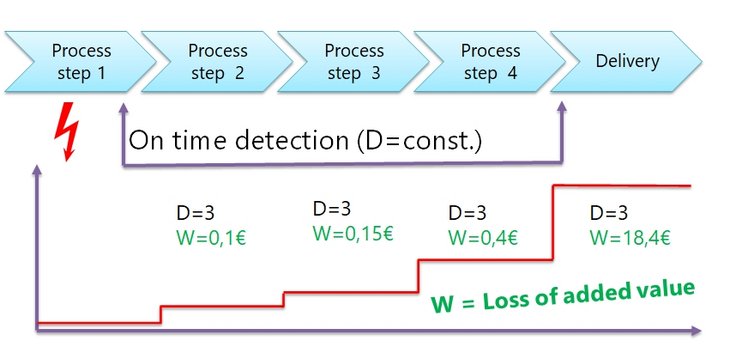Up to now, we have always used the D-assessment in the process FMEA to evaluate the ability of one or more detection actions to detect a cause or its effects in time. From our (German) point of view, this was also useful to be able to assess the risk in the process. The exact location of the detection was irrelevant for the quality of the detection.
According to the new standard, the possibility to assess according to the (subjectively) real detection was taken away. In addition, the place or time of detection is taken into account as a further criterion for the D-assessment. This means that the D-ratings are easier to assign, as they differ more from each other due to the descriptions and the additional criterion, but should no longer be adjusted to the real detection. As an example, good visual checks of systematic defects should be rated worse than poor machine checks of random ones.
In future, AIAG-VDA will take the loss of value into account in the evaluation with regard to the detection distance. We would like to present this here for general discussion.
Table 01 shows a simplified, analogous excerpt from the AIAG-VDA E assessment table Process FMEA 2019.
| D | Possibility of Detection |
| 1 | Failure cause eliminated physically (design or process related Poka-Yoke) |
| 2 | Detects failure cause, prevents failure mode and prevents output (automatic Poka-Yoke) |
| 3 | Detects failure modeinstation and prevents output (automatic) |
| 4 | Detects failure mode downstream and prevents output (automatic) |
| 5 | Detects failure mode or cause and signals error (automatic or semiautomatic) |
| 6 | Detects failure mode or cause (human) |
Table 01: Simplified, analogous excerpt from the AIAG-VDA E evaluation table Process FMEA 2019
This means that the later a defect is detected, the higher the costs in terms of rework or scrap (which we have normally already taken into account in the process effects and S-assessment) and the higher the D-assessment. For this, no official attribute separately considers the costs of the detection action.
 Figure 01: When is the error discovered with regard to value creation?
Figure 01: When is the error discovered with regard to value creation?
Figure 01 shows an "old" D-assessment after a real detection assessment (in time regarding the safeguarding of the customer), which was supplemented with the attribute "W" (value creation loss).
The loss of value added aspect and likewise the cost of the measures are in our opinion important and not negligible. We believe that the central goal of P-FMEA is to prevent or minimize the leakage of defective or faulty products to the customer. This slip-through could be represented in an additional DxO matrix.
Due to the new evaluation criterion, an DxO matrix evaluation is no longer meaningful with regard to the real detection. Thus, the meaningfulness of the D-scoring is no longer unambiguous and clear, as in practice, many teams still evaluate the effective detectionability. This offers some advantages in analysis and understanding. We suspect that in the near future, the results of FMEAs will be heterogeneous with respect to detection and be faulty.
Conclusion
We can live with the AIAG-VDA P-FMEA D-assessment, as the assignment is clearer and the AP table more generous. The prerequisite, however, is that the probability of detection disappears from the minds of everyone involved in the near future.
One possible way would be for the value-added loss and the action costs to be incorporated into the FMEA through one or two assessment factors of their own or in the form of comments, remarks or notes. Then the D-assessment could still focus on the capability of the detection measure. However, we do not think it is realistic to expect this possibility to find approval in AIAG circles in the next few years. However, it certainly does not harm the method if it is discussed in expert circles.
Author
Martin Werdich, FMEA Plus Akademy
[The article was published in the magazine FMEA Konkret, issue 12/2021, p. 18-19, and is published on RiskNET with the kind permission of the editors]




